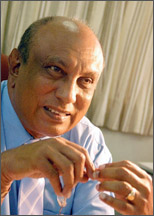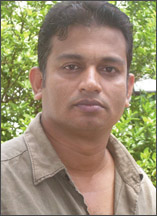Artistic Films, critiques; into the vistas of the new millennium
by Ranga Chandrarathne
 |
 |
|
Dr. Lester James Peries Tissa
Abeysekara
Guiding the nation towards a genuine application to culture |
After fifty years of producing artistic films, Sri Lankan cinema has,
now, arrived at a critical juncture where it faces an identity crisis.
Although Lester James Peris' Rekhava (Line of Destiny) is the first
artistic film and considered as a part of a wider cultural renaissance
with change of regime in 1956, it has been the culmination of the
process of intellectual discourse spearheaded by intellectuals such as
Prof. Ediriweera Sarachandra.
The 1956 cultural renaissance led to the turning of a new leaf not
only in cinema but also in other forms of art such as literature,
performing art and visual art. It was during this period that Martin
Wickremasinghe wrote Gamperaliya, the first of his trilogy, maestro
Chithra Sena produced Karadiya, Sinhalese ballet and Goerge Keyt drew
his now famous avant-garde paintings.
However, this process which commenced in the 1940's which reached its
zenith in 1956, should not be mistaken as the culminating effect of
changes in the sphere of the political scene on art and culture. It was
also not a process in search of national identity or a renaissance based
on race but it was an intellectual process in the sphere of art and
culture.
The reforms brought about by the new regime in education and the
prominent status given to Sinhala language and the Sinhala only policy
had also contributed to the renaissance.

Renuka Balasuriya and Somaratne Dissanayake- Serious audience awaits
another film of easthetic quality such as Saroja |

Prasanna Jayakody- Willing to respond to controversy and criticism
sprang from Sankara(Introspection) |

Asoka Handagama-Changing the cause of conventional cinema to explore
the intimate ties |
Tracing back to the origin of Sinhala cinema, the vital role played
by the Tamil business community in Sri Lanka who invested their money in
the Sinhala cinema, can not be undermined as they were responsible for
the setting up of basic infrastructure for cinema in Sri Lanka.
In order to minimize the cost of production, Tamil businessmen set up
film studios in Sri Lanka such as the Ceylon Studio, SPM Studio and the
Wijaya Studio. Primarily their objectives were commercial and what they
wanted was to establish Sri Lankan cinema as an industry. It was this
community who established theatres in predominantly Sinhalese speaking
areas.
Therefore, it is clear that the private sector was the pioneer in
establishing necessary infrastructure for a vibrant film industry in Sri
Lanka. Then private sector largely made up of Tamil businessmen,
invested in the production of Sinhala films.
In fact, they even invested in films made by Dr. Lester James Peries;
his second film Sandeshaya was produced by K. Gunaratnam. During the
1940's the cinema was a 'magic realism' for the audience which was used
to watch dramas on stage.
One of the significant contributions that Rekhava made to the entire
filmdom was that it not only set the stage for an intellectual cinema
but also drew a boundary across the audience in determining the
conventional and classical cinema.
Another major development in Sri Lankan cinema was the birth of the
Sri Lanka Film Corporation with unprecedented power to shape the
industry. It was the Film Corporation which drew the second line across
the audience, in categorizing films produced in Sri Lanka, in terms of
circuits, into classical films which are to be shown in the prestigious
Fifth Circuit and commercial films.
Peradeniya School which shaped the contours of diverse art forms such
as literature, drama, had also had an abiding influence on Sinhala
cinema. From Sirigunasingha who produced his seminal work Satsamudura,
D.B Nihalsinghe to Dharmasena Pathiraja, Wasantha Obeysekara represented
and propagated the Peradeniya School.
Themes on the idealistic village, love in a village, customs
dominated the early stage of Sinhala cinema; Kurulubedda, Kelahanda.
Films by M. Mastan, Somasekaran and later by Robin Thampo were
successful commercial films.
However, the genesis of the crisis in Sri Lankan cinema started with
the establishment of National Film Corporation (NFC) which wielded
unprecedented power regulating the entire process of production, the
import and the distribution of films in Sri Lanka.
One could argue that the anti-private sentiments spearheaded by the
NFC would have had a direct impact on subsequent burning of theatres and
even studios during the 1983 black July.
The NFC's influence over the industry was pervasive and adversely
affected the natural growth of the industry which was gradually gaining
ground with building up of infrastructure for a vibrant film industry in
Sri Lanka. However, after the second generation of film makers such as
Lester James Peiris, Tissa Abeysekara, the third generation challenged
the NFC's monopoly in film regulation.
This generation includes film makers who are path definers such as
Dharmasiri Bandaranayake, Parakrama Niriella, and Parakrama Silva. One
of the salient characteristic of all these film makers was that they
attempted to supersede the artificial limitations and subtle
manipulations by the NFC.
Dharmasiri Bandaranayke's seminal debut Hansa Vilak (Swan Lake) was
produced by a private investor. The brilliant debut which was
subsequently classified as classical work by the NFC itself, had won
several awards.
As Hansa Vilak is woven around the institution of family, it was
initially vehemently castigated by pseudo critics, some, on personal
grounds and others who are cultural puritans as they live in a
make-believe world fortified by traditions and social norms.
|

Hansa Vilak(Swan Lake)- Brilliant cinema debut depicting intimate
ties out of wedlock surpassing conventions which confine individuals
to social institutions |
However, what these pseudo critics have failed to understand is that
the purpose of a work of art is not to propagate an ideology or a static
culture but to explore human nature and its complexities and subtleties
of myriad human relationships which are not confined to social norms or
traditions. It is a pity that very few artists base their creations on
their personal experiences which would otherwise, be lessons of life.
For instance, Prof. Ediriweera Sarachchandra who could have written,
beyond doubt, the most authentic novel based on his life and times, had
never written such a novel based on his event-studded life.
Cultural Puritanism and cheap fantasies
From the early days, sex, the allied themes and the crisis in the
institution of family had been subjects of many a work of art. Even in
Buddhist literature, there are many instances where these issues were
explored in a spirit of enlightening society and exploring the
complexities of human behaviour; even the polygamous sexual
relationships.
Sri Lankan writers both in Sinhala and English explored and discussed
sexuality as it is an integral part of life. Martin Wickremasinghe,
Punyakante Wijenaike, Sita Kulatunga, Gunadasa Amerasekara, Simon
Navagattegama, Ameena Hussein, Romesh Gunasekara, Michael Ondatje,
Manuka Wijesinghe, Lal Medawattegedara and Shyam Selvadurai have
extensively dealt with the issues of human nature.
However, it is incomprehensible, antagonism on the part of a section
of society to cinematic creations and classical forms of music and other
forms of art when attempted to explore socio-cultural issues.
The new generation of film makers such as Asoka Handagama, Prasanna
Withanage, Sathyajit Maitipe, Vimukthi Jayasundera, and Enokaa
Sathyangani Keerthinanda have radically changed the application of media
in the Sri Lankan context.
One of the salient characteristics of their cinema is that they
explore intimate ties in a traditional set up. They have also captured
the socio-economic changes brought about by the fast moving life in the
city and draw parallels with the village. The dominant themes they
explored are of migrant workers and their lives, garment workers in the
free trade zone and how the web of social contacts formed and
socio-economic repercussions of a protracted conflict.
Another section which constitutes a minority in the field, keep on
churning out cheap fantasies whose purpose seems to keep the audience in
‘darkness’ for a period of three hours, in order to achieve their
financial ends.
This type of films would be ideal for lovers and should carry on
ideally the tag ‘couples only’ not as ‘adult only’ erroneously displayed
in posters. Worse than the formula films, the themes such as ideal love
with happy endings and marriage dominate these films.
Almost all the films, the ending was unrealistic as the beginnings
were and often the film ends with a round table appeasement of parties
to the conflict. One actress involved in the production of such films,
while enjoying a huge plate of pork insulted a path defining film maker
and his children as fanatics who creates equally fanatical films.
The remarks not only indicated the hypocritical nature of the comment
and the commentator but also the gross ignorance of the medium. It is
ironical that such cheap fantasies are being encouraged and publicized
by section of the critics who appreciate cocktails more than providing
the society with constructive criticism.
This reminds me of the constraint of literary critics of the caliber
of Reggie Siriwardene, Ajith Samaranayake, Benedict Dodampegama, and the
left- behinder of this segment Rajpal Abeynayeke who would judge and put
the society into the right track where art and culture is concerned.
The need of the hour is a genuine application to art in order to
salvage it from the present quandary which was the end result of the
counter insurgency strategy adapted by the United National Party
Government that left the country a cultural desert.
The collapse of art and culture in the face of brutal crackdown of
the insurgency which resulted in several deaths of artists stalled the
progress of classical art in 1980s. It is unfortunate that the handful
of artists, who tried to change the course of art, have continually been
subjected to harassment.
[email protected] |
